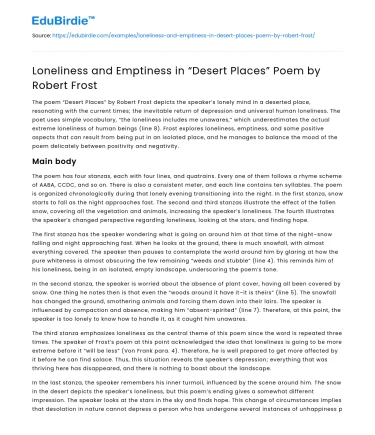The poem “Desert Places” by Robert Frost depicts the speaker’s lonely mind in a deserted place, resonating with the current times; the inevitable return of depression and universal human loneliness. The poet uses simple vocabulary, “the loneliness includes me unawares,” which underestimates the actual extreme loneliness of human beings (line 8). Frost explores loneliness, emptiness, and some positive aspects that can result from being put in an isolated place, and he manages to balance the mood of the poem delicately between positivity and negativity.
Main body
The poem has four stanzas, each with four lines, and quatrains. Every one of them follows a rhyme scheme of AABA, CCDC, and so on. There is also a consistent meter, and each line contains ten syllables. The poem is organized chronologically during that lonely evening transitioning into the night. In the first stanza, snow starts to fall as the night approaches fast. The second and third stanzas illustrate the effect of the fallen snow, covering all the vegetation and animals, increasing the speaker’s loneliness. The fourth illustrates the speaker’s changed perspective regarding loneliness, looking at the stars, and finding hope.
Save your time!
We can take care of your essay
- Proper editing and formatting
- Free revision, title page, and bibliography
- Flexible prices and money-back guarantee
The first stanza has the speaker wondering what is going on around him at that time of the night–snow falling and night approaching fast. When he looks at the ground, there is much snowfall, with almost everything covered. The speaker then pauses to contemplate the world around him by glaring at how the pure whiteness is almost obscuring the few remaining “weeds and stubble” (line 4). This reminds him of his loneliness, being in an isolated, empty landscape, underscoring the poem’s tone.
In the second stanza, the speaker is worried about the absence of plant cover, having all been covered by snow. One thing he notes then is that even the “woods around it have it–it is theirs” (line 5). The snowfall has changed the ground, smothering animals and forcing them down into their lairs. The speaker is influenced by compaction and absence, making him “absent-spirited” (line 7). Therefore, at this point, the speaker is too lonely to know how to handle it, as it caught him unawares.
The third stanza emphasizes loneliness as the central theme of this poem since the word is repeated three times. The speaker of Frost’s poem at this point acknowledged the idea that loneliness is going to be more extreme before it “will be less” (Von Frank para. 4). Therefore, he is well prepared to get more affected by it before he can find solace. Thus, this situation reveals the speaker’s depression; everything that was thriving here has disappeared, and there is nothing to boast about the landscape.
In the last stanza, the speaker remembers his inner turmoil, influenced by the scene around him. The snow in the desert depicts the speaker’s loneliness, but this poem’s ending gives a somewhat different impression. The speaker looks at the stars in the sky and finds hope. This change of circumstances implies that desolation in nature cannot depress a person who has undergone several instances of unhappiness possible to human beings (Adi 17). Readers get a different imprint of the poem; the speaker finally manages to master this situation by relating it to the desert places he has closer to his home.
One of the most evident poetic devices in Frost’s poem is alliteration. For instance, in “Snow falling and night falling fast, oh, fast,” four words start with the sound “f” (line 1). The use of alliteration helps the poet alternate between the high and low reading paces. The poem’s metrical pattern and rhyme scheme work together with alliteration to mimic the falling snow. The second example of alliteration is “smooth” and “snow” in “And the ground almost covered smooth in the snow” (line 3). The third instance of alliteration is “stubble showing” in the first stanza, “But a few weeds and stubble showing last” (line 4). This combination enables the reader to rush forward and suddenly retreat to ponder the land’s emptiness and the speaker’s intention.
Moreover, Frost uses imagery in his poem to help paint a clearer picture of the speakers setting. One example is “the ground almost covered smooth in the snow” (line 3) and “all animals are smothered in their lairs” (line 6). These two instances in the poem enable the reader to visualize the actual state of the desert. They resonate with what Adi comments about the poem: mothered animals and a blanker whiteness of snow all over the place (19). Additionally, there is the use of metaphor, for example, desert places signifying humans’ spiritual and moral wilderness. Furthermore, the field represents nature, and he sees some positive natural identity remaining after a moment of snow falling, “few weeds and stubble showing last” (line 4). Therefore, imagery and metaphor are other essential devices that enable the poem to convey its intended message.
Moreover, the poet has used an irregular rhythm to write the poem, making it sound like a true story. It helps the reader to shift from a common phenomenon to the truth. An example of this is in “Snow falling and night falling fast, oh, fast” (line 1). Midway through the poem, the aspect of snow falling is predominant, and it adds to the rhythm making the poem sound like a ducked pulse beat.
Conclusion
In conclusion, Frost’s poem reveals deep thoughts about life’s philosophy regarding loneliness and helplessness toward reality. The intensity of the depression of Frost’s speaker is described by the cold night. The poem illustrates the sharp contrast between human beings’ ability to experience feelings of isolation and connect, as illustrated by the despair in the poem’s speaker. He takes longer to accept and conquer, underscoring the transition between negativity and positivity.






 Stuck on your essay?
Stuck on your essay?

